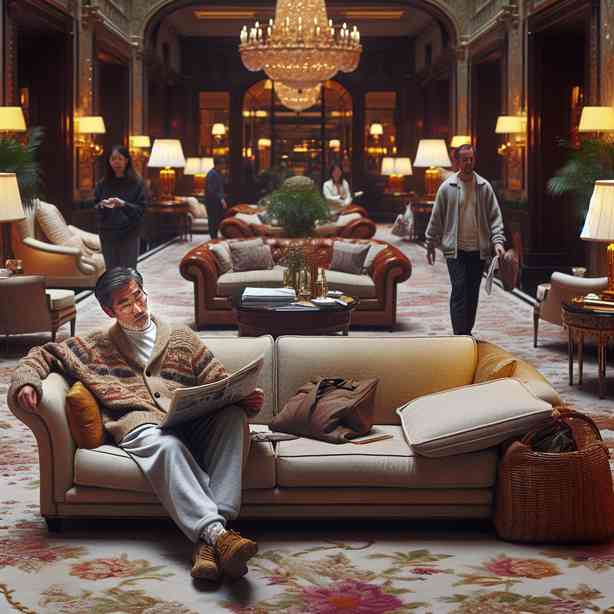
In recent years, the dynamics of public spaces in hotels have evolved dramatically. A trend that has captured the attention of hospitality experts is the behavior of certain guests who treat hotel lobbies as extensions of their personal living rooms. This behavior may seem harmless at first glance, but it has raised significant discussions about guest etiquette, the role of hotels as social spaces, and the balance between comfort and formality in these environments.
Hotel lobbies have traditionally served as transitional spaces, where guests check in and out and engage in brief interactions with hotel staff. However, with the rise of more casual and social hotel designs, the lobby has transformed into a multifunctional area, often equipped with plush seating, Wi-Fi access, and coffee bars. As a result, many guests feel invited to linger longer, blurring the lines between public and private spaces. This shift, while beneficial in many respects, poses challenges that must be addressed by hotel management to ensure a comfortable atmosphere for all guests.
One of the driving forces behind this trend is the growing desire for connection. In a world where social media dominates communication, many guests seek authentic interactions that extend beyond mere transactions. They may treat hotel lobbies as communal spaces where they can work, relax, or socialize. In essence, these guests view the lobby as an extension of their own home, where they can feel at ease and engage with others. While this can create a vibrant social atmosphere, it can also lead to conflicts when personal boundaries are not respected.
Another factor contributing to this phenomenon is the influence of modern remote working practices. With more individuals working from anywhere, hotel lobbies have become ideal locations for those seeking inspiration outside the conventional office environment. Guests wielding laptops and mobile phones often occupy tables and seating areas for prolonged periods, utilizing the lobby as a workspace. This can inadvertently make other guests feel unwelcome, especially those who expect a more traditional experience. Striking a balance between catering to these remote workers and maintaining a welcoming atmosphere for all guests is a delicate task that hotel management must navigate.
The challenge presented by guests who treat the lobby as their living room extends beyond simple etiquette. For hotel staff, navigating these interactions requires tact and a nuanced understanding of guest needs. Training staff to recognize and address various scenarios is essential. For example, if a guest monopolizes a prime seating area with their belongings, staff should approach them politely, suggesting alternative spaces or offering to assist them in finding a more suitable location. Such interactions, when handled gracefully, can enhance the guest experience while preserving the lobby’s intended purpose.
Furthermore, hotels must also consider the design elements that encourage or discourage certain behaviors. In crafting their lobby environments, hotel designers must weigh the need for comfort against the need for functionality and flow. Intuitive layouts, strategic seating arrangements, and accessible amenities can all contribute to creating a welcoming yet orderly atmosphere. For instance, providing designated work zones within the lobby can help delineate spaces for those who wish to work from the hotel while still accommodating guests looking to socialize or relax.
Guest feedback is another crucial component of this ongoing discussion. Hotels that actively solicit and respond to guest opinions can adapt their services and environments to better meet the needs of all visitors. Establishing feedback channels, whether through surveys, comment cards, or online platforms, enables hotels to gauge how well they are managing the lobby experience. Actively listening to guests can lead to innovative solutions that enhance the overall atmosphere of the lobby, accommodating varied guest expectations while maintaining an environment conducive to relaxation and social engagement.
To further enhance this experience, hotels may consider integrating additional amenities. Coffee stations, light refreshments, and entertainment options—such as live music or art installations—can invigorate the lobby experience, drawing guests in while cultivating a sense of community. These offerings create a more dynamic atmosphere where guests feel invited to spend time, interact, and enjoy the space, all while respecting the comfort of others.
Another critical aspect of dealing with guests who treat the lobby like a living room is setting clear expectations through signage and staff communication. Informative signs can guide guests on appropriate behavior, outlining time limits for certain seating areas or designating quiet zones for those who wish to work or relax in peace. Additionally, staff should be trained to communicate these expectations tactfully, ensuring that guests feel respected and valued rather than chastised or unwelcome.
Ultimately, the role of hotel lobbies is evolving, and understanding the nuances of guest behavior is vital for creating a harmonious environment. By recognizing the desire for social connection and the shift toward remote work, hotels can strategically adapt their spaces and services to cater to the diverse needs of their guests. Fostering an atmosphere of inclusivity while respecting individual boundaries will enable hotels to thrive in this new era of hospitality.
In conclusion, as guests continue to treat hotel lobbies as extensions of their homes, it is essential for hotels to adapt their strategies to accommodate this shift in behavior. By implementing thoughtful design choices, encouraging open communication, and offering appropriate amenities, hotels can create a welcoming environment that respects the diverse preferences and needs of all guests. This evolution not only enhances the guest experience but also reinforces the lobby’s role as a central hub of connection and engagement within the hotel. In doing so, hotels can navigate the complexities of modern hospitality while preserving the charm and warmth that make them quintessential destinations.


